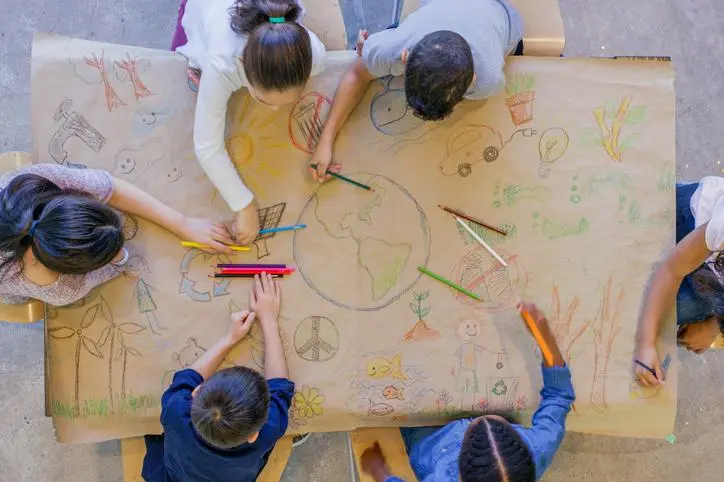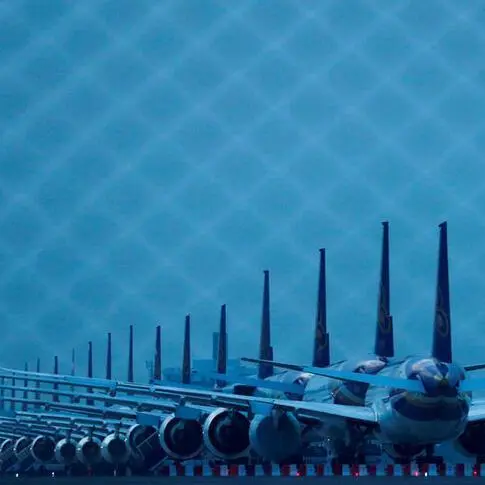PHOTO
In the middle of the twentieth century, the tiny Gulf nation of Kuwait looked very different from what it does today. The discovery of oil and the development of the oil industry in Kuwait led to the slow disappearance of a way of life that the country had known for centuries. In the middle of the sixties, the ruthless bulldozing of old traditional buildings – that had existed when Kuwait was a pearl diving, shipping, and trading nation- led to a complete change in the landscape. Along with the landscape, it changed the material culture. Before the discovery of oil, handcrafting was a source of livelihood and coping with the harsh living conditions. Weaving Sadu and investing the yarn with vibrant colors allowed the weaver some control over her living environment, which was harsh and brutal. With time, these handicrafts became symbols of Kuwait’s national identity.
Different types of handicrafts were practiced in Kuwait. They included beautiful dhows built by the Al Gallaleef’s traditional ship builders who created magnificent sailing boats that the mariners used to sail to India and the East coast of Africa. Some Kuwaiti women, especially the ones who lived with their tribes in the desert, wove sadu, a form of Bedouin weaving that has, over the years, transcended from being a craft to an art form. Bisht was a form of urban weaving practiced in the urban areas of Kuwait. Other handicrafts included palm frond weaving, crafting Kuwaiti chests or boxes, and jewelry making.
With money pouring in after the discovery of oil and subsequent modernization and mechanization, young Kuwaiti craftspeople increasingly opted for jobs in the public sector. They no longer wanted to invest time and energy in crafts that were time and labor-intensive and not financially viable. Soon, the handicraft sector of Kuwait started to die down. Individuals like Sheikha Altaf Salem Al Ali Al Sabah made it their mission to resurrect certain aspects of Kuwait’s heritage. She co-founded the Sadu Weaving Cooperative at the right time to infuse new life into the dying craft of Sadu, modernize it, and make it more relevant.
Without her efforts, Sadu would have died and not enjoyed the special status under UNESCO that it enjoys now. But what about other crafts local to Kuwait? The other crafts were dying a sure death because of apathy, lack of patronage, and paucity of crafters. The Old Kuwaiti Crafts Association was formed to help revive old crafts and give them a new lease of life. Salman Al Bolond, President of the Old Kuwaiti Crafts Association and former Superintendent of the Kuwait National Museum, who had observed the struggles of the artisans and craftspersons, is empathetic. “Handcrafters do not receive much government or private sector support,” said Al Bolond. “They find it very difficult to survive on these crafts. In Kuwait, there used to be 200 artisans practicing different types of crafts. But right now, only six or seven craftspeople can truly depend on it for their livelihood. The rest live life differently. They have transitioned to a smooth lifestyle in an oil-rich community.”
Many challenges face craftspeople today. Al Bolond prefers to highlight two main challenges. He says, “The first challenge is the one craftsmen face between their products and mass-produced, cheap items. The other challenge is the gap between them and society, which looks at the craftsman/woman as someone belonging to the lower strata of society. They do not treat craftspeople with the respect they deserve.” The lack of opportunities to commercially sell locally-made handicrafts in Kuwait is a big headache for artisans. “There used to be many such shops before the invasion, but no more,” shares Al Bolond. “There are no shops in the airport, museum, or other public space. Around three and a half million foreigners and 120 nationalities live in Kuwait, but they don’t know much about our traditions.” He rues the lack of visitors to the local Museums. “Most of our visitors to the museums are Indians. The rest are either not interested, or they don’t know. Locally-made Kuwaiti crafts could serve as beautiful souvenirs to take home for the millions of expatriate residents, and the government and craftsmen are losing out on an important source of revenue.”
Al Bolond adds that one cannot live or survive on occasional bazaars and fairs. “You don’t have enough events or activities which allow craftspeople to survive on their craft. This is where the Old Crafts Association contributes. The association aims to support craftspeople to lead a comfortable life by helping them navigate new rules and providing more work.” This is in keeping with the government’s aim to reduce the public sector load by encouraging artisans to start their businesses and improve their sustainability. “Craftsmen need better regulations from the Ministry of Justice and the National Council for Culture, Arts and Letters.” Al Bolond has sought help from the Minister of Information and the Minister of Labour. “We are trying to work on suggestions that will provide the craftsmen the opportunity to work throughout the year,” said Al Bolond. “We also organize lectures for the crafters and provide training courses to better their skills.”
“One way to help craftspeople without making it look like charity is to keep their products in your shop. Pay them once you sell it,” Al Bolond urges local businesses.” However, all is not lost. Recently, some Ministries intervened. “ I thank the Ministry of Finance for giving licenses to craftsmen to run shops from their homes. They don’t need a shop anymore. They can sell through social media, and that makes life so much easier for craftspeople who do not have the money for downpayment to open shops, employ people, etc.” The Old Crafts Association began a few months back with fifty founding members. In a short time, the membership has grown to 135. Although the summer months were sluggish, the association picked up momentum, and now, they have exhibitions and showings every two to three weeks. “I am happy to say half of our members are women,” says Al Bolond. “And unlike public perception, all our members work very hard. Most manage two jobs. They work for the government and pursue their crafts after working hours. Some are retired people who prefer to work instead of getting bored.” Salman Al Bolond wants all Kuwaitis who feel they have the skill and talent for a craft to come forward and join the organization.
The members of the Old Crafts Association practice different types of crafts. A young Kuwaiti crafter creates laptop and iPhone covers out of palm fronds; some shipbuilders build ships and boats; tailors work on traditional clothing like Bisht; potters make utensils; artisans work with recycled material; artisans crochet and make thoub al Kuwaiti. Jalila Al Qattan makes handmade jewelry from semiprecious stones. “I joined the Old Kuwaiti Crafts Society because I am a Kuwaiti and an artisan with a craft,” she says. Speaking of the benefits she enjoys as a member, Jalila, a well-known artist, says, “I joined the association mainly to meet other craftspeople and to be introduced to government associations, as it is good for exposure.” According to her, crafts are a form of art that should be appreciated and valued. “Heritage crafts are particularly important because they tell a story of the history of a nation. Humanity is richer by its cultural and heritage diversity.”
Ali Majid Dashti specializes in plaster and acrylic crafting. He joined the association to have better access to the public and improve his knowledge through regular exchanges with other members. Ali believes he still has not realized the full benefits of joining the organization. “The reason for this is that the public is still not aware of handicrafts made by using plaster nor do they appreciate it.” But the journey has started to a better awareness and sustainability for heritage crafts. It will be interesting to see how the organization navigates the coming months.
© 2022 Arab Times Kuwait English Daily. All Rights Reserved. Provided by SyndiGate Media Inc. (Syndigate.info).





















